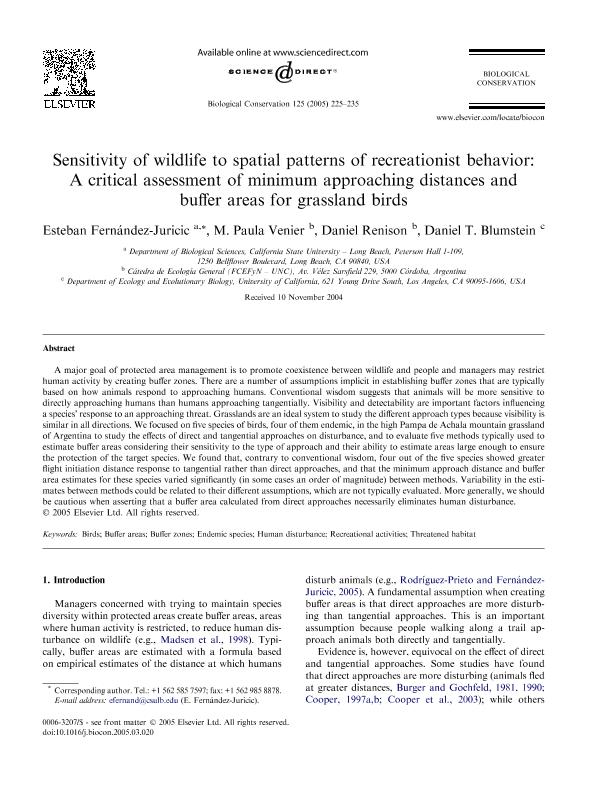Artículo
Sensitivity of wildlife to spatial patterns of recreationist behavior: A critical assessment of minimum approaching distances and buffer areas for grassland birds
Fecha de publicación:
09/2005
Editorial:
Elsevier
Revista:
Biological Conservation
ISSN:
0006-3207
Idioma:
Inglés
Tipo de recurso:
Artículo publicado
Clasificación temática:
Resumen
A major goal of protected area management is to promote coexistence between wildlife and people and managers may restrict human activity by creating buffer zones. There are a number of assumptions implicit in establishing buffer zones that are typically based on how animals respond to approaching humans. Conventional wisdom suggests that animals will be more sensitive to directly approaching humans than humans approaching tangentially. Visibility and detectability are important factors influencing a species' response to an approaching threat. Grasslands are an ideal system to study the different approach types because visibility is similar in all directions. We focused on five species of birds, four of them endemic, in the high Pampa de Achala mountain grassland of Argentina to study the effects of direct and tangential approaches on disturbance, and to evaluate five methods typically used to estimate buffer areas considering their sensitivity to the type of approach and their ability to estimate areas large enough to ensure the protection of the target species. We found that, contrary to conventional wisdom, four out of the five species showed greater flight initiation distance response to tangential rather than direct approaches, and that the minimum approach distance and buffer area estimates for these species varied significantly (in some cases an order of magnitude) between methods. Variability in the estimates between methods could be related to their different assumptions, which are not typically evaluated. More generally, we should be cautious when asserting that a buffer area calculated from direct approaches necessarily eliminates human disturbance.
Archivos asociados
Licencia
Identificadores
Colecciones
Articulos(IIBYT)
Articulos de INSTITUTO DE INVESTIGACIONES BIOLOGICAS Y TECNOLOGICAS
Articulos de INSTITUTO DE INVESTIGACIONES BIOLOGICAS Y TECNOLOGICAS
Citación
Fernandez Juricic, Esteban; Venier, Maria Paula; Renison, Daniel; Blumstein, Daniel T.; Sensitivity of wildlife to spatial patterns of recreationist behavior: A critical assessment of minimum approaching distances and buffer areas for grassland birds; Elsevier; Biological Conservation; 125; 2; 9-2005; 225-235
Compartir
Altmétricas




